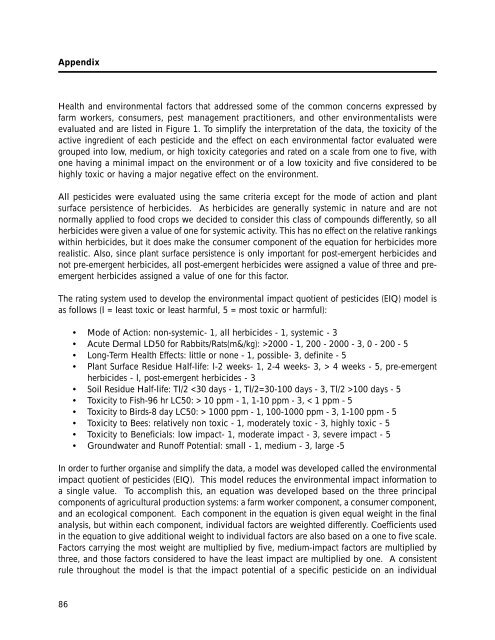GM Crops: The First Ten Years - International Service for the ...
GM Crops: The First Ten Years - International Service for the ...
GM Crops: The First Ten Years - International Service for the ...
Create successful ePaper yourself
Turn your PDF publications into a flip-book with our unique Google optimized e-Paper software.
Appendix<br />
Health and environmental factors that addressed some of <strong>the</strong> common concerns expressed by<br />
farm workers, consumers, pest management practitioners, and o<strong>the</strong>r environmentalists were<br />
evaluated and are listed in Figure 1. To simplify <strong>the</strong> interpretation of <strong>the</strong> data, <strong>the</strong> toxicity of <strong>the</strong><br />
active ingredient of each pesticide and <strong>the</strong> effect on each environmental factor evaluated were<br />
grouped into low, medium, or high toxicity categories and rated on a scale from one to five, with<br />
one having a minimal impact on <strong>the</strong> environment or of a low toxicity and five considered to be<br />
highly toxic or having a major negative effect on <strong>the</strong> environment.<br />
All pesticides were evaluated using <strong>the</strong> same criteria except <strong>for</strong> <strong>the</strong> mode of action and plant<br />
surface persistence of herbicides. As herbicides are generally systemic in nature and are not<br />
normally applied to food crops we decided to consider this class of compounds differently, so all<br />
herbicides were given a value of one <strong>for</strong> systemic activity. This has no effect on <strong>the</strong> relative rankings<br />
within herbicides, but it does make <strong>the</strong> consumer component of <strong>the</strong> equation <strong>for</strong> herbicides more<br />
realistic. Also, since plant surface persistence is only important <strong>for</strong> post-emergent herbicides and<br />
not pre-emergent herbicides, all post-emergent herbicides were assigned a value of three and preemergent<br />
herbicides assigned a value of one <strong>for</strong> this factor.<br />
<strong>The</strong> rating system used to develop <strong>the</strong> environmental impact quotient of pesticides (EIQ) model is<br />
as follows (l = least toxic or least harmful, 5 = most toxic or harmful):<br />
• Mode of Action: non-systemic- 1, all herbicides - 1, systemic - 3<br />
• Acute Dermal LD50 <strong>for</strong> Rabbits/Rats(m&/kg): >2000 - 1, 200 - 2000 - 3, 0 - 200 - 5<br />
• Long-Term Health Effects: little or none - 1, possible- 3, definite - 5<br />
• Plant Surface Residue Half-life: l-2 weeks- 1, 2-4 weeks- 3, > 4 weeks - 5, pre-emergent<br />
herbicides - l, post-emergent herbicides - 3<br />
• Soil Residue Half-life: Tl/2 100 days - 5<br />
• Toxicity to Fish-96 hr LC50: > 10 ppm - 1, 1-10 ppm - 3, < 1 ppm - 5<br />
• Toxicity to Birds-8 day LC50: > 1000 ppm - 1, 100-1000 ppm - 3, 1-100 ppm - 5<br />
• Toxicity to Bees: relatively non toxic - 1, moderately toxic - 3, highly toxic - 5<br />
• Toxicity to Beneficials: low impact- 1, moderate impact - 3, severe impact - 5<br />
• Groundwater and Runoff Potential: small - 1, medium - 3, large -5<br />
In order to fur<strong>the</strong>r organise and simplify <strong>the</strong> data, a model was developed called <strong>the</strong> environmental<br />
impact quotient of pesticides (EIQ). This model reduces <strong>the</strong> environmental impact in<strong>for</strong>mation to<br />
a single value. To accomplish this, an equation was developed based on <strong>the</strong> three principal<br />
components of agricultural production systems: a farm worker component, a consumer component,<br />
and an ecological component. Each component in <strong>the</strong> equation is given equal weight in <strong>the</strong> final<br />
analysis, but within each component, individual factors are weighted differently. Coefficients used<br />
in <strong>the</strong> equation to give additional weight to individual factors are also based on a one to five scale.<br />
Factors carrying <strong>the</strong> most weight are multiplied by five, medium-impact factors are multiplied by<br />
three, and those factors considered to have <strong>the</strong> least impact are multiplied by one. A consistent<br />
rule throughout <strong>the</strong> model is that <strong>the</strong> impact potential of a specific pesticide on an individual<br />
86
















